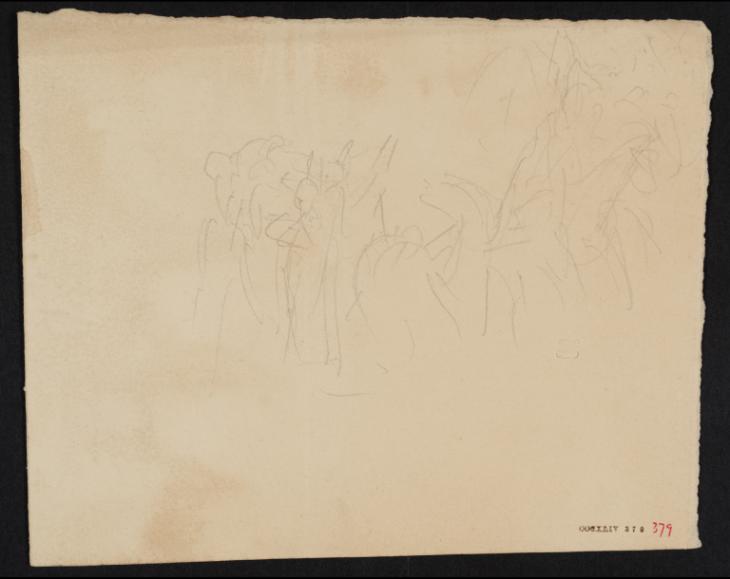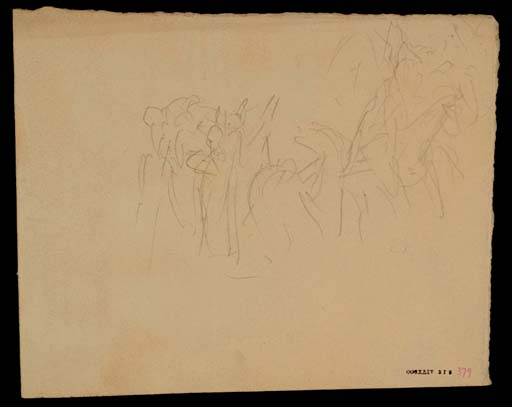Joseph Mallord William Turner Figures Gesturing to Passing Horses and Riders c.1820-40
Image 1 of 2
Joseph Mallord William Turner,
Figures Gesturing to Passing Horses and Riders
c.1820-40
Joseph Mallord William Turner 1775–1851
Figures Gesturing to Passing Horses and Riders c.1820–40
D34871
Turner Bequest CCCXLIV 379
Turner Bequest CCCXLIV 379
Pencil on white wove paper, 132 x 163 mm
Inscribed in red ink ‘379’ bottom right
Stamped in black ‘CCCXLIV 279’ bottom right
Inscribed in red ink ‘379’ bottom right
Stamped in black ‘CCCXLIV 279’ bottom right
Accepted by the nation as part of the Turner Bequest 1856
References
1830
A.J. Finberg, A Complete Inventory of the Drawings of the Turner Bequest, London 1909, vol.II, p.1144, CCCXLIV 379, as ‘The Spectres’, c.1830–41.
On the left of this very slight, loose drawing, a group of figures stands with arms raised in salute, farewell or protest to at least two horsemen passing to the right in a flurry of pencil strokes. Between, at least one figure appears no kneel. Finberg presumably felt the drawing had the quality of a flurried apparition, dubbing it ‘The Spectres’.1
It is possible that Turner was recording or recalling something he had actually witnessed, or that he was setting out an idea for a classical, historical or Napoleonic composition. There is a faint echo of George Romney’s practice of making multiple fluid pencil or ink drawings for seldom-realised historical compositions (for example John Howard Visiting a Lazaretto, of about 1791–2: Tate T03547), and of Turner’s own exploratory Old Master-like designs for compositions in the early Calais Pier sketchbook (Tate; Turner Bequest LXXXI).
Horses rarely play a prominent part in Turner’s finished designs, but among his intricate watercolour vignettes for illustrations there are a few with figures and horses, such as Napoleon at Marengo (Tate D27663; Turner Bequest CCLXXX 146),2 engraved in 1830 for Rogers’s Italy (Tate impression: T04639), another battle scene, Hohenlinden (National Gallery of Scotland, Edinburgh),3 engraved in 1837 for Thomas Campbell’s Poetical Works (Tate impression: T04773) and Lord Ullin’s Daughter (also National Gallery of Scotland),4 another Campbell subject (Tate impression: T04774).
Finberg placed this drawing somewhat arbitrarily in a large ‘Miscellaneous: black and white’ category dated to about 1830–41;5 the range has been extended here to cover the 1820s. Meredith Gamer’s ‘Vignette watercolours’ section in the present catalogue ranges between 1826 and 1845, but the purpose and date of the present work seems likely to remain elusive.
Verso:
Blank
Matthew Imms
August 2016
How to cite
Matthew Imms, ‘Figures Gesturing to Passing Horses and Riders c.1820–40 by Joseph Mallord William Turner’, catalogue entry, August 2016, in David Blayney Brown (ed.), J.M.W. Turner: Sketchbooks, Drawings and Watercolours, Tate Research Publication, February 2017, https://www


